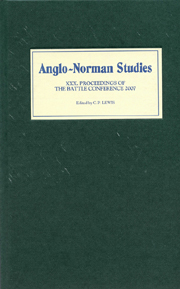Book contents
- Frontmatter
- Contents
- LIST OF ILLUSTRATIONS, MAPS, AND TABLES
- EDITOR'S PREFACE
- ABBREVIATIONS
- The Normans in Welsh History (R. Allen Brown Memorial Lecture)
- William Marshal, Lancelot, and Arthur: Chivalry and Kingship
- Grades of Ordination and Clerical Careers, c. 900–c. 1200
- Evesham J and Evesham L: Two Early Twelfth-Century Manorial Surveys
- Aspects of Church Reform in Wales, c. 1093–c. 1223
- Lay Charters and the Acta of Henry II
- Reinventing Normans as Crusaders? Ralph of Caen's Gesta Tancredi
- Kings, Lords, Charters, and the Political Culture of Twelfth-Century Wales
- Identifying the Warrior on the Pre-Heraldic Battlefield
- St Nicholas the Pilgrim and the City of Trani between Greeks and Normans, c. 1090–c. 1140
- The ‘Resurgence’ of Powys in the Late Eleventh and Early Twelfth Centuries
- Interpreter Families and Anglo-Welsh Relations in the Shropshire-Powys Marches in the Twelfth Century
- A Taste for the Antique? Henry of Blois and the Arts
Grades of Ordination and Clerical Careers, c. 900–c. 1200
Published online by Cambridge University Press: 12 September 2012
- Frontmatter
- Contents
- LIST OF ILLUSTRATIONS, MAPS, AND TABLES
- EDITOR'S PREFACE
- ABBREVIATIONS
- The Normans in Welsh History (R. Allen Brown Memorial Lecture)
- William Marshal, Lancelot, and Arthur: Chivalry and Kingship
- Grades of Ordination and Clerical Careers, c. 900–c. 1200
- Evesham J and Evesham L: Two Early Twelfth-Century Manorial Surveys
- Aspects of Church Reform in Wales, c. 1093–c. 1223
- Lay Charters and the Acta of Henry II
- Reinventing Normans as Crusaders? Ralph of Caen's Gesta Tancredi
- Kings, Lords, Charters, and the Political Culture of Twelfth-Century Wales
- Identifying the Warrior on the Pre-Heraldic Battlefield
- St Nicholas the Pilgrim and the City of Trani between Greeks and Normans, c. 1090–c. 1140
- The ‘Resurgence’ of Powys in the Late Eleventh and Early Twelfth Centuries
- Interpreter Families and Anglo-Welsh Relations in the Shropshire-Powys Marches in the Twelfth Century
- A Taste for the Antique? Henry of Blois and the Arts
Summary
The clergy were a central part of medieval society and medieval political activity, and were responsible for creating many surviving medieval sources; thus all medievalists, irrespective of their interests, need to know something about how they were defined, as clerics, from the rest of society, and how their careers were structured. The principal function of clergy, and the feature that principally separated them from the laity, was to perform or to help to perform sacraments, the most significant and frequently celebrated of which was mass. Clerics were licensed to celebrate mass or to assist with its celebration by a series of initiation rites, in other words ordination to a succession of clerical grades, from doorkeeper up to priest. These rites separated clergy from laity. In addition, there were visible markers – tonsure and separate clothing – but these did not go back quite so far in Christian history as ordination. Tonsure began to be adopted in the sixth century and was a requirement from the early seventh; likewise, as far as clothing was concerned, clergy in the Roman empire wore the long garments appropriate for upper-class males, and it was only in the sixth century, when upper-class laymen adopted knee-length tunics, that clerical clothing became distinct from secular clothing. Tonsure and clothing made clerics visibly different, but ordination was more important in establishing their status.
Ordination to the various grades was usually spaced out over quite a long time; it therefore formed a framework marking out phases of a cleric's life. However, it was not only ordination which provided this framework.
- Type
- Chapter
- Information
- Anglo-Norman Studies 30Proceedings of the Battle Conference 2007, pp. 41 - 61Publisher: Boydell & BrewerPrint publication year: 2008



